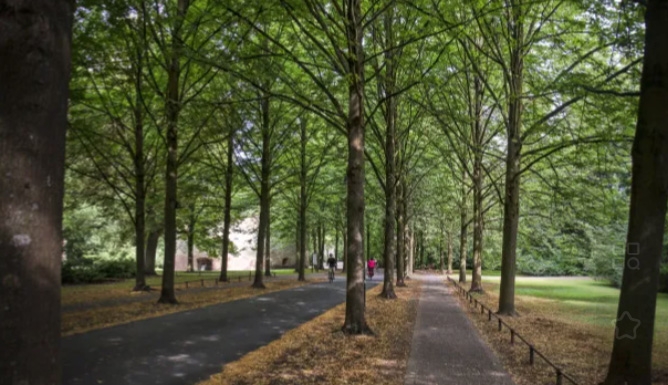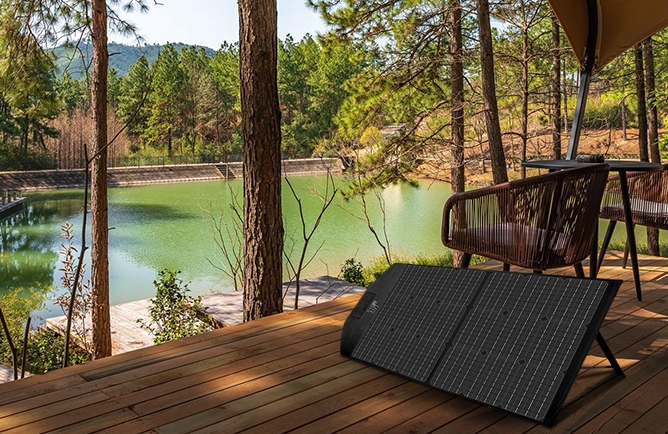As the demand for renewable energy continues to grow, portable solar panels have become a popular choice for outdoor enthusiasts, off-grid living advocates, and emergency preparedness enthusiasts alike. Lightweight, easy to transport, and capable of generating clean electricity on the go, these devices provide a convenient solution for powering small appliances and charging devices in remote areas. However, a common question arises: can portable solar panels work in shade? The short answer is yes, but not efficiently. In this article, we will explain more information about this and tell you some solutions.

How Does Portable Solar Panel Work?
Folding solar panels, like their rooftop counterparts, work by converting sunlight into electricity through the photovoltaic (PV) effect. When sunlight hits the solar cells (usually made of silicon), it excites electrons, creating a flow of electric current. This direct current (DC) electricity is then either stored in batteries or converted into alternating current (AC) using an inverter, depending on the intended use.
Most portable solar panels are designed to be lightweight and foldable, incorporating monocrystalline or polycrystalline solar cells. Monocrystalline panels, known for their high efficiency and sleek black appearance, generally perform better in low-light conditions than polycrystalline panels, which are cheaper but less efficient.
What Happens When Portable Solar Panels in Shade?
Foldable solar panels are a convenient and eco-friendly way to generate electricity on the go, whether for camping, RV use, or emergency power. However, their efficiency depends heavily on access to sunlight. When these panels are placed in shaded conditions, their performance can decline significantly. Here's what happens when portable solar cell panels are in shade.
- Reduced Power Output. The most immediate effect of shade is a drop in power output. Solar photovoltaic panels convert sunlight into electricity using photovoltaic (PV) cells. When shade covers any part of the panel, it blocks sunlight from reaching the cells, reducing the panel's ability to generate electricity. Depending on the amount and type of shading, partial, full, or intermittent, output can fall dramatically, sometimes by more than 80%.
- Hot Spots and Damage Risk. Shading can cause certain areas of a solar pv panel to heat up more than others, a condition known as a "hot spot". Hot spots occur when shaded cells start to resist the current from unshaded cells, potentially causing damage over time. While this is less of a concern in high-quality portable panels with protective features, it's still something to watch for during long-term use.
- Impact on Charging Devices. Since portable solar panels are often used to charge batteries or power small electronics, any drop in energy output can delay charging times or interrupt device operation. In shaded conditions, a phone that normally charges in two hours might take four or more, or not charge at all.
Factors That Affect Shade Areas Performance
Type of Solar Cells. The type of solar cells used in portable panels plays a major role in how well they perform in partial shade. Monocrystalline panels, for example, tend to be more efficient and perform slightly better in low-light conditions compared to polycrystalline panels. Some high-end portable panels use solar cells with bypass diodes or innovative materials like amorphous silicon, which can tolerate shading better than traditional cells.
Time of Day and Sun Angle. The position of the sun changes throughout the day, so a panel in partial shade in the morning might receive full sunlight by noon. Understanding the movement of shadows and adjusting the panel’s position accordingly can help minimize performance losses due to temporary shading.
Environmental Conditions. Weather elements such as clouds, fog, or dust can create diffused light, which reduces overall irradiance and mimics the effect of light shade. While panels can still function under diffuse light, the efficiency is lower than under direct sunlight. Dust or dirt accumulation also mimics the effect of partial shading, so keeping panels clean is essential for maintaining peak performance.

Practical Tips for Using Solar Panels in Shaded Areas
Using portable solar panels in shaded areas presents unique challenges. Shade significantly reduces a panel's ability to generate electricity, as solar cells rely on direct sunlight for optimal performance. However, with a few strategic approaches, it's still possible to make the most of your solar setup even in less-than-ideal conditions. Here are some practical tips for maximizing the efficiency of foldable solar panels in shaded environments.
- Choose High-Efficiency Solar Panels. When sunlight is limited, efficiency becomes crucial. Look for monocrystalline solar panels, which tend to perform better in low-light conditions compared to polycrystalline or thin-film panels. These panels have a higher energy conversion rate, meaning they can generate more power from the same amount of light. Our website offers various types of portable solar panels, such as 60W, 80W, 100W portable solar panel, etc.
- Adjust Panel Position Frequently. Folding solar panels are designed for mobility, take advantage of that feature. Adjust the angle and position of your panels throughout the day to follow the sun's path and avoid shaded areas caused by trees, buildings, or other obstructions. Even small changes in positioning can lead to noticeable improvements in energy output.
- Use a Solar Charge Controller with MPPT. A solar charge controller regulates the energy flowing from the panel to your battery. MPPT (Maximum Power Point Tracking) controllers are especially effective in partially shaded or fluctuating light conditions. They continuously adjust the voltage and current to extract the maximum power available, improving overall efficiency.
- Elevate Panels Off the Ground. Placing solar cell panels directly on the ground can limit their exposure to sunlight due to grass, uneven terrain, or passing shadows. Elevating your panels on a stand or mount helps keep them in better alignment with the sun and away from minor obstructions that can cause shading.
- Keep Panels Clean. Dust, dirt, and debris can further reduce the efficiency of solar pv panels, especially when already dealing with shade. Clean your panels regularly with a soft cloth and water to ensure they absorb as much light as possible.
Conclusion
While folding solar panels can technically work in shade, their output is dramatically reduced. For critical power needs or high-demand devices, relying on this is not advisable. However, with the right planning, equipment, and expectations, they can still be useful in shaded environments for trickle charging or low-power applications. If you're often in shaded environments but still want to leverage solar energy, consider combining portable solar panels with high-capacity power stations, positioning panels in sunlit areas, or using alternative backup charging methods (like wind or hand-crank generators). If you want to know more about portable pv panel or have any question, Inverter Online Shop will give you a help.
